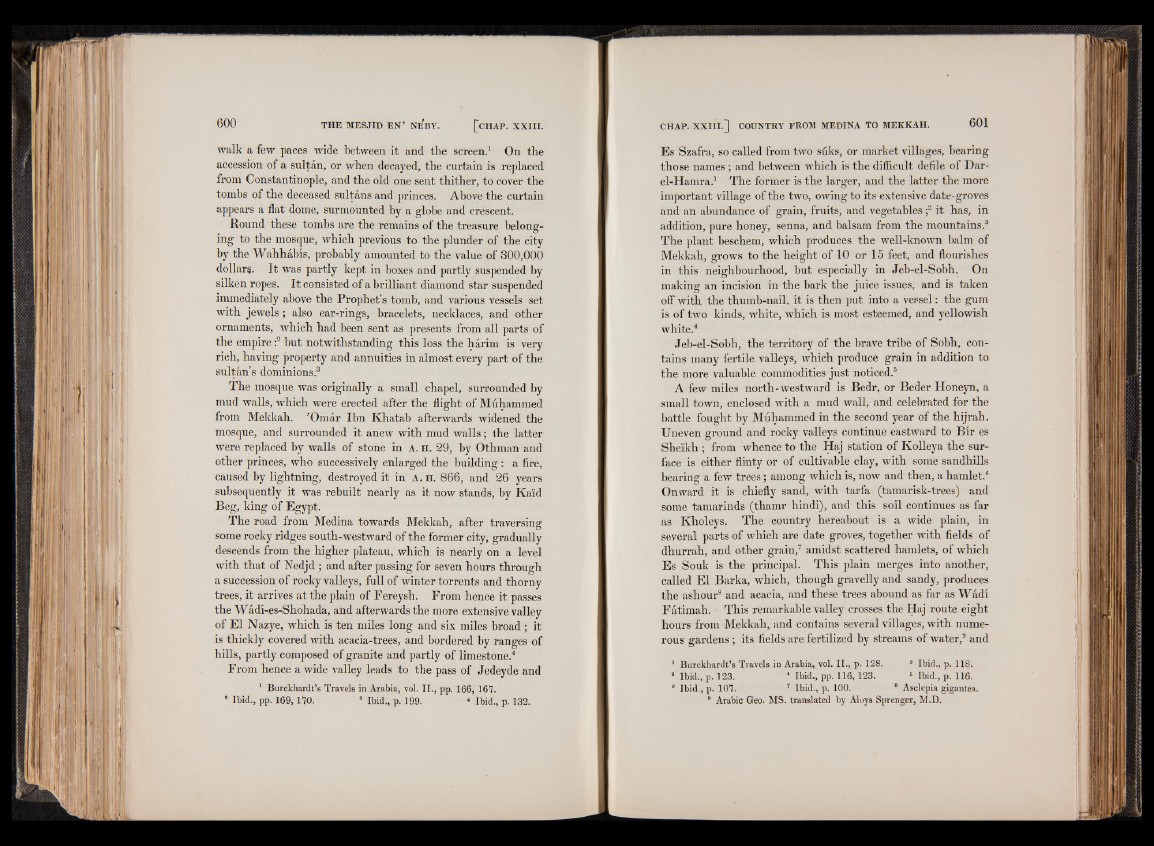
walk a few paces wide between it and the screen.1 On the
accession of a sultan, or when decayed, the curtain is replaced
from Constantinople, and the old one sent thither, to cover the
tombs of the deceased sultans and princes. Above the curtain
appears a flat dome, surmounted by a globe and crescent.
Round these tombs are the remains of the treasure belonging
to the mosque, which previous to the plunder of the city
by the Wahhabis, probably amounted to the value of 300,000
dollars. It was partly kept in boxes and partly suspended by
silken ropes. It consisted of a brilliant diamond star suspended
immediately above the Prophet’s tomb, and various vessels set
with jewels; also ear-rings, bracelets, necklaces, and other
ornaments, which had been sent as presents from all parts of
the empire :2 but notwithstanding this loss the harim is very
rich, having property and annuities in almost every part of the
sultan’s dominions.3
The mosque was originally a small chapel, surrounded by
mud walls, which were erected after the flight of Muhammed
from Mekkah. ’Omar Ibn Khatab afterwards widened the
mosque, and surrounded it anew with mud walls; the latter
were replaced by walls of stone in A. H. 29, by Othman and
other princes, who successively enlarged the building : a fire,
caused by lightning, destroyed it in a . h . 866, and 26 years
subsequently it was rebuilt nearly as it now stands, by Ka'id
Beg, king of Egypt,
The road from Medina towards Mekkah, after traversing
some rocky ridges south-westward of the former city, gradually
descends from the higher plateau, which is nearly on a level
with that of Nedjd ; and after passing for seven hours through
a succession of rocky valleys, full of winter torrents and thorny
trees, it arrives at the plain of Fereysh. From hence it passes
the Wadi-es-Shohada, and afterwards the more extensive valley
of El Nazye, which is ten miles long and six miles broad ; it
is thickly covered with acacia-trees, and bordered by ranges of
hills, partly composed of granite and partly of limestone.4
From hence a wide valley leads to the pass of Jedeyde and
Es Szafra, so called from two suks, or market villages, bearing
those names; and between which is the difficult defile of Dar-
el-Hamra.1 The former is the larger, and the latter the more
important village of the two, owing to its extensive date-groves
and an abundance of grain, fruits, and vegetables ;2 it has, in
addition, pure honey, senna, and balsam from the mountains.3
The plant beschem, which produces the well-known balm of
Mekkah, grows to the height of 10 or 15 feet, and flourishes
in this neighbourhood, but especially in Jeb-el-Sobh. On
making an incision in the bark the juice issues, and is taken
off with the thumb-nail, it is then put into a vessel: the gum
is of two kinds, white, which is most esteemed, and yellowish
white.4
Jeb-el-Sobh, the territory of the brave tribe of Sobh, contains
many fertile valleys, which produce grain in addition to
the more valuable commodities just noticed.6
A few miles north-westward is Bedr, or Beder Honeyn, a
small town, enclosed with a mud wall, and celebrated for the
battle fought by Muhammed in the second year of the hijrah.
Uneven ground and rocky valleys continue eastward to Bir es
Sheikh ; from whence to the Haj station of Kolleya the surface
is either flinty or of cultivable clay, with some sandhills
bearing a few trees; among which is, now and then, a hamlet.6
Onward it is chiefly sand, with tarfa (tamarisk-trees) and
some tamarinds (thamr hindi), and this soil continues as far
as Kholeys. The country hereabout is a wide plain, in
several parts of which are date groves, together with fields of
dhurrah, and other grain,7 amidst scattered hamlets, of which
Es Souk is the principal. This plain merges into another,
called El Barka, which, though gravelly and sandy, produces
the ashour3 and acacia, and these trees abound as far as Wadi
Fatimah. This remarkable valley crosses the Haj route eight
hours from Mekkah, and contains several villages, with numerous
gardens; its fields are fertilized by streams of water,9 and
1 Burckhardt’s Travels in Arabia, vol. II., p. 128. 8 Ibid., p. 118.
8 Ibid., p. 123. 4 Ibid., pp. 116, 123. 5 Ibid., p. 116.
6 Ibid., p. 107. 7 Ibid., p. 100. 8 Asclepia gigantea.
8 Arabic Geo. MS. translated by Aloys Sprenger, M.D.